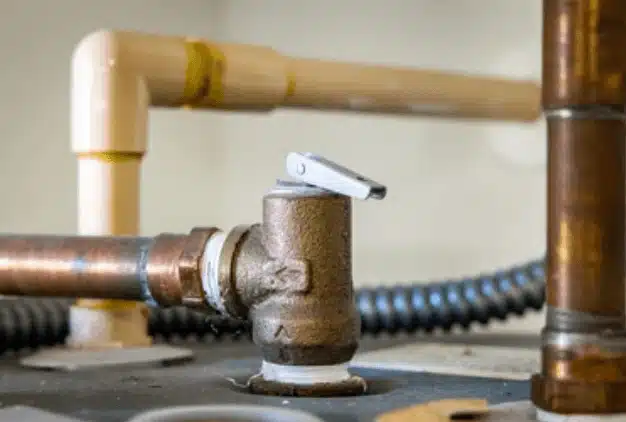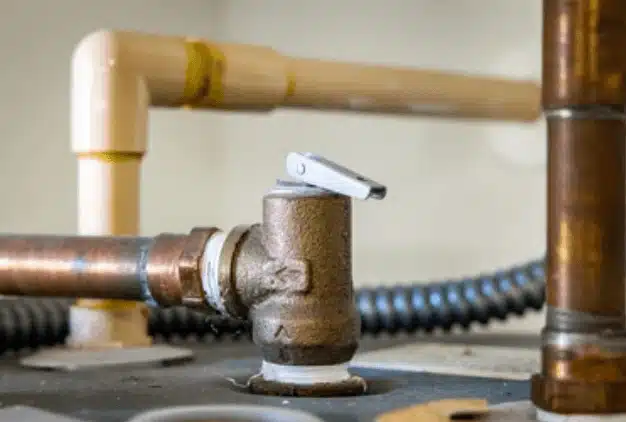A water heater pressure relief valve is an essential component of any water heating system.
It plays a crucial role in maintaining the proper functioning of the water heater and ensuring the safety of the system.
In this article, we will delve into the functions of a water heater pressure relief valve and discuss why it is important to address any issues related to it promptly.
Before we understand the workings of a relief valve, let’s first grasp its mechanism.
A relief valve is designed to release excessive pressure from the water heater tank.
It consists of a lever and a valve. When the pressure inside the tank exceeds the preset limit, the valve opens, allowing the excess pressure to escape.
This prevents the tank from rupturing due to the build-up of pressure.
The relief valve is equipped with a spring that keeps the valve closed during normal operation.
However, when the pressure inside the tank surpasses the recommended level, the spring is compressed, causing the valve to open.
This release of pressure helps to maintain the integrity of the tank and prevent any potential hazards.
The relief valve acts as a safety device to protect the water heater from excessive pressure.
Without a relief valve, the pressure would continue to rise.
The tank could potentially explode, causing significant damage and posing a risk to the inhabitants of the property.
Many modern water heaters are equipped with a temperature and pressure relief valve, commonly known as the T&P valve.
This valve serves a dual purpose by not only releasing excessive pressure but also discharging hot water and steam if the temperature inside the tank becomes too high.
This further enhances the safety of the system and prevents any potential accidents.
If you notice that your water heater pressure relief valve leaking, it is essential to investigate the cause and address it promptly.
A water heater pressure relief valve leaking can indicate an underlying issue with the system, which, if left unattended, could lead to more significant problems.
There are several reasons why a relief valve may leak. It could be due to a faulty valve, excess pressure and temperature
It is necessary to identify the cause accurately to implement the appropriate solution.
Signs to look out for a faulty relief valve
A faulty relief valve may exhibit various signs. These include a continuous drip, water discharge even when the system is not in use, or water pooling around the valve area.
If you notice any of these signs, it is crucial to take immediate action to prevent further damage to the system.
Ignoring a leaking relief valve can have severe consequences.
It not only wastes water but can also lead to increased energy consumption and high utility bills.
Additionally, a faulty relief valve compromises the safety of the water heater system, putting you and your property at risk.
If you notice that your water heater pressure relief valve is leaking, there are a few steps you can take to address the issue.
To stop a water heater pressure relief valve from leaking, follow these 9 steps:
Taking these steps will help address the issue of a leaking water heater pressure relief valve and ensure the safety and proper functioning of your water heater system.
If the leak persists, it may be necessary to replace the relief valve.
If you are unsure about how to proceed or if the leak does not stop even after following the aforementioned steps, it is advisable to seek the assistance of a professional plumber.
They have the expertise and experience to diagnose and repair any issues with your water heater pressure relief valve.
Replacing a relief valve can be a challenging task for individuals who are not well-versed in plumbing.
It requires knowledge of the system and the correct tools for the job.
Therefore, it is generally recommended to leave the replacement of a relief valve to professionals who can ensure that it is done correctly and safely.
Like any other component, the relief valve of a water heater is subject to wear and tear over time.
Therefore, it is essential to replace it periodically to maintain the efficiency and safety of the system.
If you notice any signs of leakage or malfunctioning in your relief valve, it is an indication that it needs replacement.
Additionally, if your water heater is more than 5 years old, it is recommended to replace the relief valve as a preventive measure.
Experts recommend replacing the relief valve every 3-5 years, depending on the manufacturer’s recommendations and the specific conditions of your water heater system.
Regular maintenance and inspection by a professional plumber can help identify any issues and determine the appropriate time for replacement.
Professional advice on choosing the right relief valve
When it comes to selecting a replacement relief valve, it is advisable to consult with a professional plumber.
They can recommend the right type and model of relief valve that suits your specific water heater system.
This ensures compatibility and optimal performance of the relief valve.

Not having a water heater pressure relief valve installed can lead to several potential consequences that can compromise the safety of your water heater system and your property.
Without a relief valve, the pressure inside the water heater tank can continue to rise unchecked.
This can result in the tank bursting, causing extensive damage to your property and potentially injuring anyone in the vicinity.
Exploring the risks associated with excessive pressure
Excessive pressure can cause various issues, such as leaks, pipe bursts, and damage to the water heater itself.
It puts a strain on the entire system, leading to increased wear and tear and decreased efficiency.
This can result in the need for costly repairs or even premature replacement of the water heater.
A properly functioning relief valve provides peace of mind by ensuring that the pressure in the water heater tank remains within safe limits.
It safeguards the system, prevents damage, and reduces the risk of accidents due to excessive pressure or temperature.
In conclusion, a water heater pressure relief valve is a critical component that plays a vital role in maintaining the functionality and safety of your water heating system.
Regular maintenance, prompt attention to any leaks, and periodic replacement of the relief valve are essential to ensure the optimal performance and longevity of your water heater.
If you encounter any issues or are unsure about how to proceed, it is always best to seek the assistance of a professional plumber, such as Al Rooter Plumbing Company.

